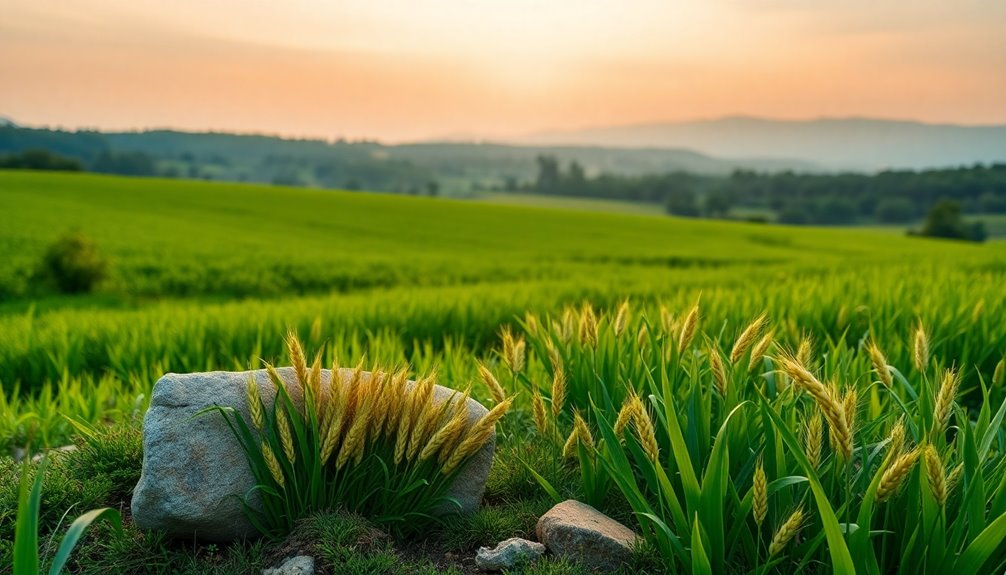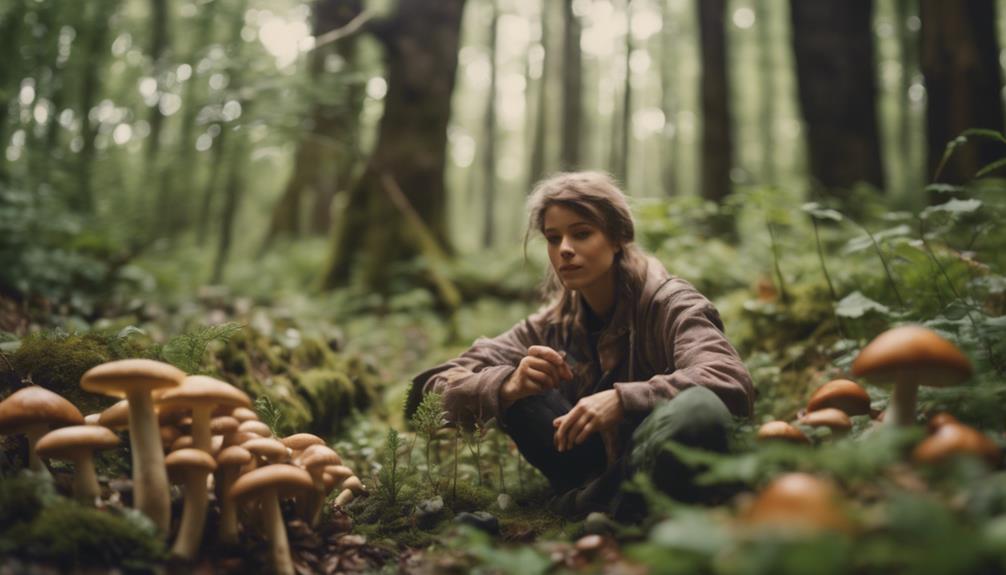If you spot garlic mustard, look for a shiny, heart-shaped leaf and a strong garlic smell when crushed, usually in shady wooded areas. Knotweed shows up as bamboo-like stems with dense clusters of tiny white flowers, often along riverbanks or disturbed sites. Recognizing these early signs helps you stop their spread quickly. If you keep exploring, you’ll discover effective ways to manage and control these invasive species before they damage native habitats.
Key Takeaways
- Recognize garlic mustard by its glossy, heart-shaped leaves and garlic smell when crushed.
- Identify knotweed by its bamboo-like stems and clusters of tiny white flowers.
- Early detection of these invasives is crucial for effective management and preventing spread.
- Both species thrive in disturbed habitats like riverbanks, roadsides, and woodland edges.
- Prompt action—manual removal or targeted herbicides—helps control invasives and protect native ecosystems.

When you encounter unfamiliar plants in the wild, invasive species often stand out as some of the easiest to identify first. They tend to dominate areas where native habitats once thrived, pushing out indigenous plants and disrupting ecosystems. Recognizing these invasives early on is vital for anyone determined to reclaim natural spaces. Two common invaders you’ll likely come across are garlic mustard and knotweed, both of which have aggressive tendencies that threaten native biodiversity.
Garlic mustard is a herbaceous plant with glossy, heart-shaped leaves and a distinctive garlic smell that becomes noticeable when crushed. It often appears in shady, woodland areas—precisely where native plants struggle to compete against its rapid spread. This plant’s ability to produce large quantities of seeds and its capacity to grow in a variety of soil conditions make it a formidable invader. If you notice garlic mustard taking over a woodland edge or understory, it’s a clear signal that the native habitat is under threat. The good news is that early detection allows you to apply specific control strategies. Hand-pulling or digging out young plants can be effective if done before seed production begins. For larger infestations, targeted herbicide treatments can help, but it’s essential to follow guidelines to avoid damaging native flora. The goal is to remove garlic mustard completely, preventing it from reseeding and establishing a new foothold.
Garlic mustard, with its garlic smell and rapid spread, signals a threatened woodland habitat. Act early to control it.
Knotweed, on the other hand, is a highly invasive, fast-growing perennial with bamboo-like stems and dense clusters of tiny white flowers. It thrives along riverbanks, roadsides, and disturbed areas—anywhere it can find a foothold outside its native habitat. Once established, knotweed forms thick thickets that outcompete native plants, reduce biodiversity, and even damage infrastructure by forcing its way into cracks and foundations. Control strategies for knotweed are more demanding, often requiring a combination of mechanical removal, herbicide application, and ongoing management. Because knotweed can regenerate from small fragments, meticulous removal is essential. Cutting back the plant repeatedly over the growing season, combined with targeted herbicide use, can weaken its root system over time. Persistent effort is necessary to prevent its return and restore the native habitat you’re aiming to protect. Understanding invasive plant habits and preferred environments is crucial for effective management.
In your fight against invasive plants like garlic mustard and knotweed, understanding their habits and preferred environments is key. Recognize the signs early, act swiftly, and implement effective control strategies to give native plants a fighting chance. Your efforts help preserve the natural balance, allowing native species to thrive once again and reclaim the wild spaces they’ve lost.
Frequently Asked Questions
How Can I Safely Remove Invasive Garlic Mustard and Knotweed?
To safely remove garlic mustard and knotweed, start with manual removal by pulling out plants, making sure to remove roots completely. Wear gloves to protect your skin. For larger infestations, consider herbicide options—use a targeted, systemic herbicide for knotweed and a selective one for garlic mustard. Always follow label instructions carefully and dispose of the plants properly to prevent spreading and reclaim your space from these invasive foes.
Are There Native Plants That Can Replace Invasive Species in My Area?
You can replace invasive garlic mustard and knotweed with native alternatives that thrive locally. Look for native plants like wild columbine, goldenrod, or native grasses, which support local ecosystems and resist invasive species. By choosing these plant replacements, you’ll free your landscape from invasive control and promote healthy, resilient native plant communities. Embrace this change to restore balance and enjoy a vibrant, native-rich environment around you.
What Are the Long-Term Ecological Impacts of These Invasive Plants?
You might be surprised to learn invasive plants like garlic mustard and knotweed can cause up to 90% ecological disruption, drastically reducing native biodiversity. Over time, they outcompete local species, leading to biodiversity loss and weakened ecosystems. This ongoing invasion threatens your natural environment’s health and resilience. Taking action now helps restore balance, giving native plants a fighting chance and freeing your landscape from invasive dominance.
Can Invasive Plants Like Garlic Mustard and Knotweed Spread Indoors?
Yes, invasive plants like garlic mustard and knotweed can spread indoors if you attempt indoor cultivation. They might escape containment, invading your space and disrupting your environment. You must prioritize pest control and proper containment methods to prevent their spread. Don’t let these invasive species take over your home or garden — stay vigilant, handle them responsibly, and protect your space from unwanted ecological intrusion.
How Do Climate Changes Affect the Spread of These Invasive Species?
Climate change accelerates the invasive spread of garlic mustard and knotweed by creating warmer, wetter conditions that favor their growth. As temperatures rise and rainfall patterns shift, these plants can thrive in new areas, outcompeting native species. You can fight back by staying vigilant, removing invasive plants early, and supporting conservation efforts. Don’t let climate change limit your control—take action now to protect your environment from invasive spread.
Conclusion
By learning to identify garlic mustard and knotweed early, you become a true defender of your local ecosystem. Spotting these invaders is like catching a wildfire before it spreads—saving your environment from chaos. The more vigilant you are, the more you prevent these invasive plants from taking over your favorite outdoor spaces. Remember, your quick action can stop these relentless invaders in their tracks and protect nature’s delicate balance for generations to come.









